Negative Oil Prices – Economic Implications
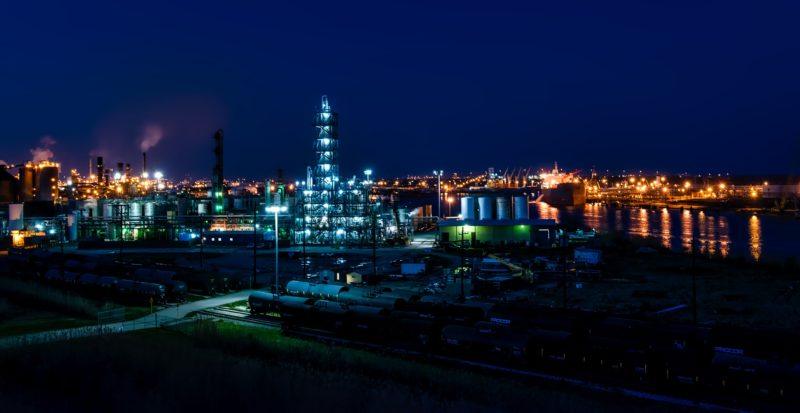
On Monday 20th April, West Texas Intermediate (WTI) Crude Oil futures for May delivery traded at $-40.32 per 42 gallon barrel (bbl), a decline of 260% in a single day. The impact was sufficient to drag the contract for June delivery down to $6.50/bbl. By the time the May contract expired at $10.01/bbl on Tuesday 21st April, financial, as well as commodity, markets were agog with a mixture of shock and awe. The previous largest single one day price move in WTI futures had been a fall of 35% back in 1991. The chart below shows the price action and volume of contracts traded during the last three months. Even by the standards of the commodity markets this move was quite extraordinary:
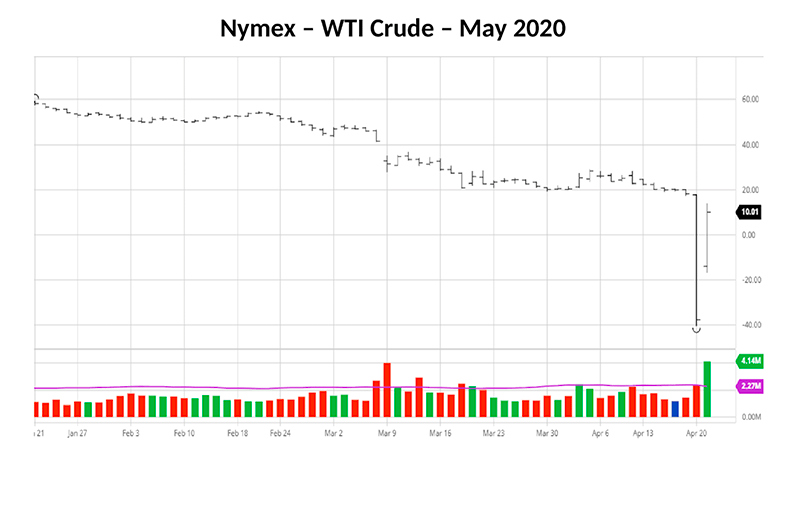
To investors used to owning stocks or bonds the concept of a negative price may seem anathema; after all, the lowest a stock can trade is zero, so why should a commodity be different? The answer is technical. WTI futures contracts are settled by physical delivery at Cushing in Oklahoma. The storage capacity at Cushing is 73mln bbls. The next chart shows how storage demand has varied over the last few years, and 2020 is a clear outlier:
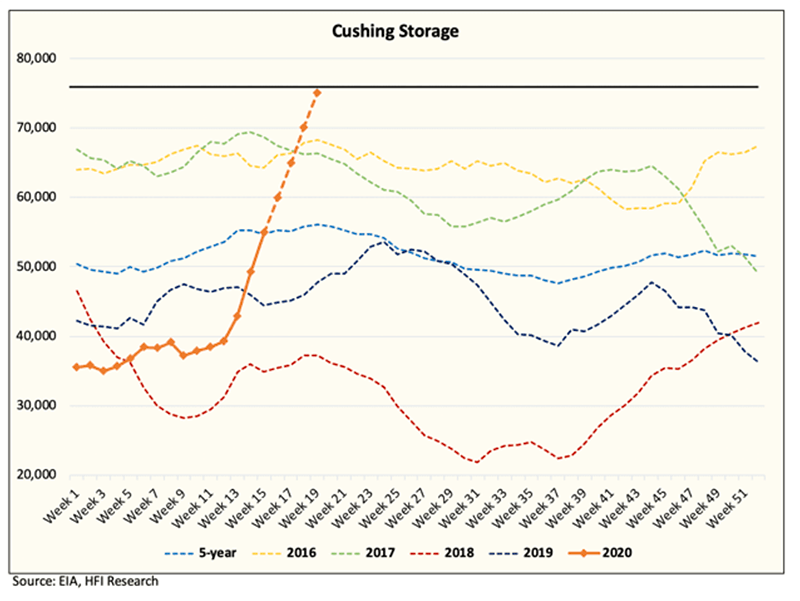
According to the latest estimates (22nd April) from the Energy Information Administration (EIA), capacity at Cushing is down to 16mln bbl. Total US storage is estimated to be around 653mln bbl. As of 17th April 518.6mln bbl was already in tank. With the weekly buildup of inventory running at between 10mln and 19mln bbl, tanks tops will be reached by mid-August.
The EIA went on to report that floating storage had also reached a record high of 160mln bbl last week. This has had a knock-on effect for the price of oil tanker charter rates. According to data from Clarksons Platou, Very Large Crude Carrier (VLCC) rates, which during 2019 averaged $25,600/day, have averaged $103,800/day during 2020 YTD. The week commencing April 20th saw prices spike to $185,700/day. Paying top dollar for floating tanker space is not a complete solution, however; the main US oil terminals are all fully booked until mid-May.
During the current crisis, the price of oil has been subjected to a combined supply and demand shock. First the COVID-19 pandemic dented global demand, then Russia and Saudi Arabia failed to agree on production quotas, leading the second and third largest producers in the world to simultaneously flood the market with product. For Russia and, especially, Saudi Arabia the marginal cost of production is lower than for the majority of US oil producers. This confluence of twin shocks was always going to fall hardest on the price of WTI. Although of higher quality than Brent Crude, it has traded at a price discount ever since the fracking production revolution gathered momentum in the late 2000s. Grist was added to the mill in 2011, as geopolitical instability in the Middle East drove the price of Brent Crude and WTI above $100/bbl.
Brent Crude remains the global benchmark, but its price has not been immune to the vicissitudes of the US oil market. With US oil terminals at capacity, further anomalies in the price of WTI futures are to be anticipated at the end of May (when the June contract expires) and, quite possibly, at the end of June. Brent Crude futures contracts, unlike WTI, are cash settled, so their expiration behaviour should be more muted, but the world has finally woken up to the magnitude of the oil glut.
The chart below shows the normal response to a widening of the Brent/WTI spread; As Brent becomes more expensive, US exports normally rise. These, however, are far from normal times:
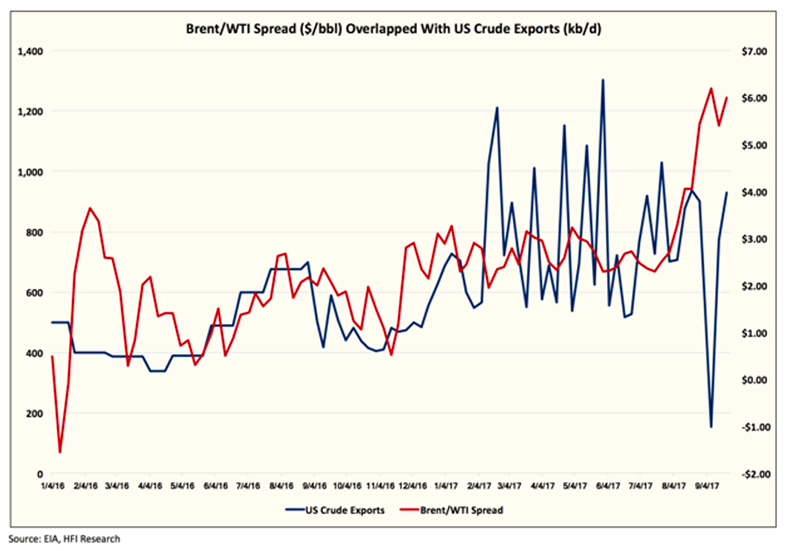
The price spread between Brent Crude and WTI for June delivery remains heightened at above $6.50/bbl (29th April). This might appear counterintuitive given the global lack of demand, but oil research firms such as HFI Research believe there to be a significant tightness of supply in the physical market for oil. This shortage is less obvious in the cash price of Brent but it is reflected in the spreads between Brent and higher quality alternatives, many of which are trading at the largest premium seen for more than two years. Supply shortages for higher grade crude is cold comfort for WTI producers for whom shut-ins of production are the only way to quickly adjust to the drop in demand.
The need for supply reduction is clear from the infographic below which estimates break-evens for global oil production from different geographic locations. Production cost estimates vary widely, dependent upon methodology, but Rystad’s comparison remains sobering news for the over-leveraged US oil and gas sector:
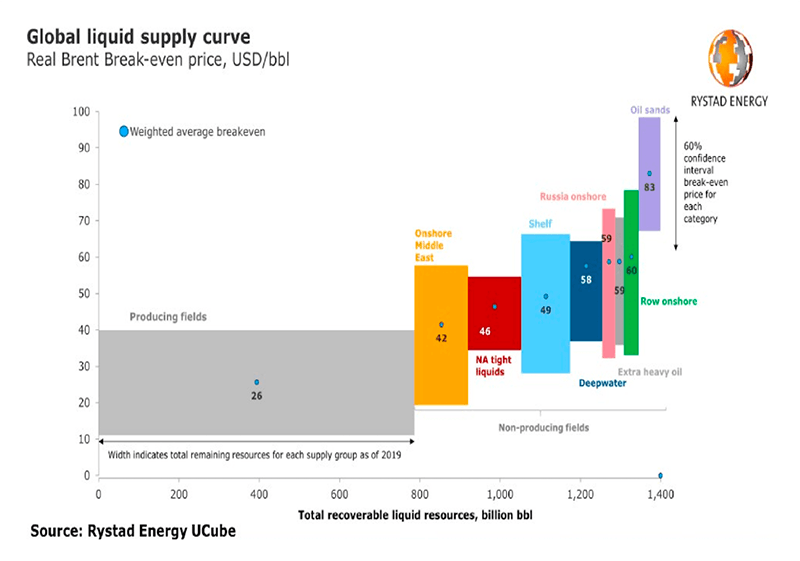
Given the geopolitical tension created by the recent crisis, a country-to-country comparison is perhaps more useful. In geographic terms, average US producer break-even is around $40/bbl, for Russia it is $19/bbl and for Saudi Arabia the highest estimate appears to be $9/bbl: the lowest, as little as $3/bbl.
Unsurprisingly, the US oil industry has not rested on its laurels; since March 8th the Baker Hughes US Rig Count has fallen from 683 wells to 378. Putting this into perspective, the next chart shows the change in rigs over the last 25 years:
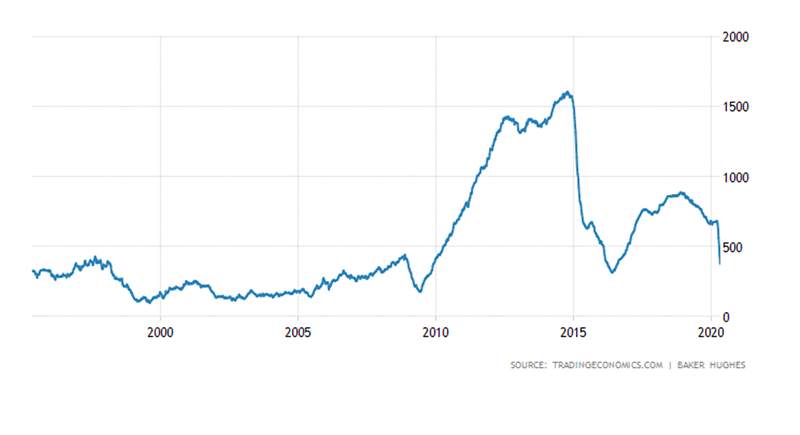
Stepping back from the technicalities of supply, demand and storage in the oil market during the next two months, the more important factor to consider is the pace at which oil demand will rebound. Surging demand for tanker capacity has precipitated an exponential rise in freight rates for VLCC and other, smaller oil vessels. Elsewhere, as world trade activity has slowed, freight rates have collapsed. The chart below shows the Baltic Dry Freight Index over the past five years:
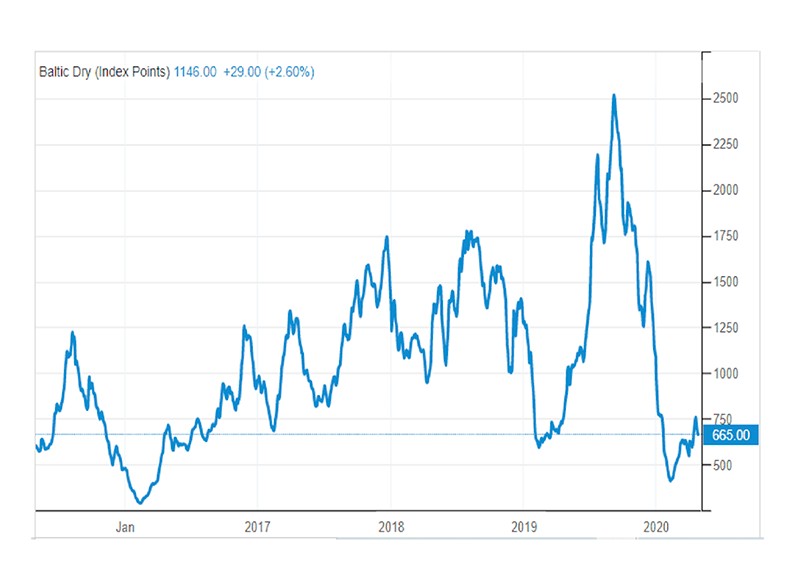
Prices for dry freight, driven by the rates for Capesize vessels, had already begun to decline from multi-year highs even before the pandemic dampened demand. Dry freight, however, is cyclical and, whilst forecasts for demand have been revised substantially lower, the depth of the Baltic Index price decline seems less dramatic when compared to last year. The chart below compares the price of the BDRY ETF in 2020 with the same period in 2019:
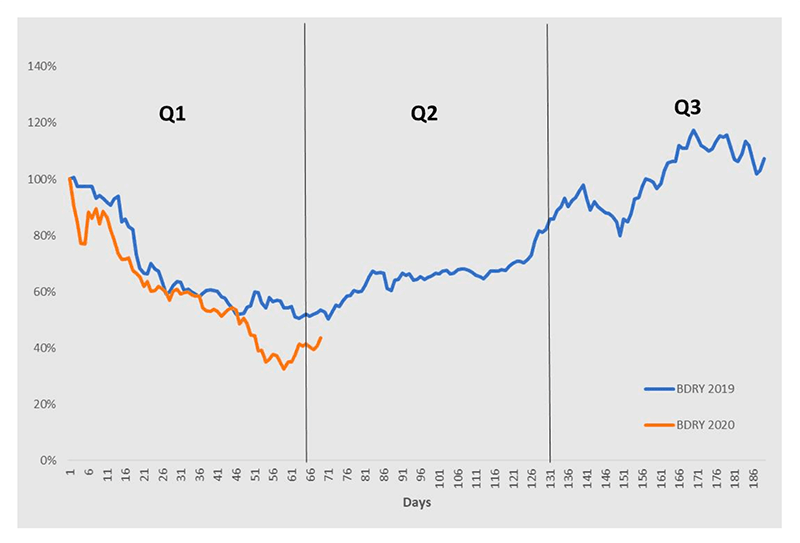
Coinciding with the fortunes of the stock market, dry freight prices appear to have stabilised since late March. A broadly similar pattern is evident in 2018, 2017 and 2016. Hopes for dry freight rates and global trade in general are firmly pinned on a timely ending of the global lock-down.
Looking beyond oil prices and freight rates, the supply of US natural gas has begun to decline. According to EIA research from 2018 around 12% of total natural gas production comes from associated-dissolved production – in other words gas produced as a by-product of drilling for oil. As oil well shut-ins accelerate gas supply diminishes. In this environment, if oil should rally, natural gas may rise more rapidly still. The chart below shows US natural gas price changes over the last six years. Its volatility puts crude oil in the shade:

Natural gas often shows a negative correlation to the price of oil, so a marginal rebound in demand may ignite a sharp rebound in the price.
Global demand for oil and gas will recover from the sudden shock of the pandemic. Price declines in natural gas have constrained supply since early in 2019, so a small rebound in demand may see prices rise rapidly. The recovery in oil demand may be slower, but the effect of shut-ins, together with the logistics of shipping, port and pipeline capacity, make it likely that oil will also stage a rebound, albeit, later than gas and over a longer period.
The longer-term economic implications of the oil price shock are more difficult to divine. A low oil price makes renewable energy less economically competitive, yet the resilience of global supply-chains has been tested and shown wanting. Government policy will continue to favour green energy solutions, yet damage to the oil and gas industry from the recent price collapse could be severe. The chart below estimates the number of US bankruptcies based on a $10, $20 and $30 average oil price over the next two years:

Industry commentators estimate that shut-ins of US oil production will reduce global production by around 6mln bpd; this still leaves the market in surplus. According to rating agency Moody’s, between now and 2024, US and Canadian oil exploration and production companies will see $86bln of debt mature. Pipeline operators are more indebted still; they have $123bln of debt to repay over the same period. The chart below (prior to the 20th April collapse in WTI) shows the dire performance of a selection of energy stocks and related ETFs since the beginning of the year:

Under the current US administration, relief for the oil and gas industry will be a high priority. In early April, Friends of the Earth warned that ExxonMobil, Chevron, and Conoco may be eligible for $19.4bln in government largesse, whilst just 12 fracking firms might qualify for a further $24.1bln of bailout funds.
According to a recent estimate from Business Insider, the US energy sector has a market capitalisation of around $700bln. Without further official support or a swift rebound in demand, one should anticipate several banks entering the energy business by default. No doubt they will remain sanguine, as they can now sell their corporate bonds to the ultimate buyer of last resort, the Federal Reserve. With a mandate to purchase up to $750bln of corporate debt, what better use could there be of the taxpayers’ money than buying beleaguered oil and gas company debt? It is a win win, fulfilling the central bank’s dual mandate of maintaining price stability whilst simultaneously seeking to support full employment.
While I do not believe the oil and gas industry will escape unscathed, government and central bank intervention will reduce the destruction of businesses and jobs, both in the industry itself and the services industries which support it. The slow ‘new-normalisation’ post-COVID means that a ‘V’- shaped recovery seems increasingly unlikely. A ‘tick-shaped’ one, however, might not be implausible. The price of oil and gas will be resurgent in 2021, if not before; sadly, the world economy may take a while longer to heal.










